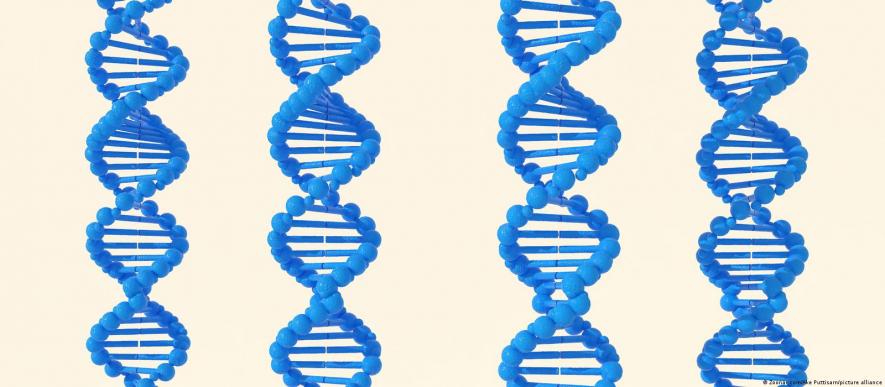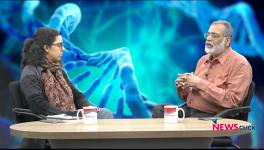The Human Genome: The Most Important Map Ever Produced

Twenty years ago today, an international group of scientists in the Human Genome Project (HGP) published the very first sequence of the human genome.
"This is the most important, most wondrous map ever produced by humankind," then-US president Bill Clinton said in June 2000, when the first draft of the human genome sequence was revealed at the White House.
The map itself consisted of three billion units of DNA, essentially a blueprint of a human being. While the sequence was partially incomplete and assembled from bits of several people's DNA, the HGP was a monumental achievement of technology and science.
Genome mapping promised many things. We would discover our ancestral histories. We would discover how genes are involved in diseases. We would read our genome sequences like coffee grains in a cup to predict if we develop diseases in the future. But by then we would have developed the therapies needed to treat those diseases.
Some of these developments have come to pass, others were fanciful. But a revolution in biological sciences began in 2003, as genome technologies transformed our understanding of human disease, our evolutionary history and what it means to be human.
The medical genetics revolution
Genomic medicine has been at the heart of the biological revolution. By sequencing the genomes of more than a million people since 2003, scientists have seen how genetic variation between people affects the risk of disease.
"The idea that you can get the whole genome sequence of a sick baby and understand why they're sick within days is remarkable," said David Curtis, a professor of medical genetics at University College London, UK.
For Curtis, it's this routine use of genetic technology in clinical practice that is the biggest benefit to come from the HGP.
"In the last few years of big sequencing studies, we've found the first gene for schizophrenia. Now we have 10. If these genes are damaged, it has a huge effect on your schizophrenia risk," Curtis told DW.
And it's not just schizophrenia where we've linked genes with diseases. Scientists have found mutated genes that cause cancers, heart disease, diabetes, you name it. The next big benefit lies in being able to create new therapies by studying the genetic mutations in the lab.
We've already seen some success in gene-based therapies, from retraining immune cells to fight cancer to using CRISPR-Cas9 gene editing tools to treat sickle cell disease.
"Genetics is very helpful to study diseases and there's massive scope for genetic therapies," said Curtis.
The limits of medical genetics
But the new boom has also shown the limits of genetic medicine. The fact remains that genes are just one factor in disease outcome, and few inherited diseases are caused by mutation in a single gene.
In the case of schizophrenia, Curtis said, only about 1% of people with the disease have a mutation in one of those 10 identified genes. In total, there are more than 250 genetic "risk factors" for schizophrenia. The sheer number of risk factors, plus the fact we don't understand how these contribute to the disease, create a real challenge for medicine.
"Some people have a mutation and they haven't got schizophrenia, or they've got a different disease entirely. The whole relationship between genetic mutation and disease has gotten shakier [since genome sequencing]," said Curtis.
Grandad was a neanderthal, and other human evolutionary tales
Where genome sequencing has been truly groundbreaking is in evolutionary biology.
"We can compare the human genome sequence to those of our close relatives and place our species within that broader evolutionary context. It's shown us that human history was much more dynamic than anyone could have predicted," Anders Bergstrom, an evolutionary biologist at the University of East Anglia, UK, told DW.
Scientists studying the genome sequences of early and modern humans have shown that our ancestors interbred with other hominins like Neanderthals and Denisovans. We now have insights into the lives of Neanderthal communities in central Europe, providing clues about their population decline, as well as tracing the genetic heritage of long-lost people like the Minoans in modern-day Cretans.
By studying ancient DNA and the little traces of ancestors inside of us, we're understanding how our species has expanded across the world, brought cultural advances like farming to distant lands, and developed resistances to diseases along the way.
![]()

Genome sequencing studies have shown how early humans interbred with NeanderthalsImage: Tom Bjorklund/Max Planck Institute for Evolutionary Anthropology/REUTERS
What is a human?
The biggest questions about genetics have yet to be answered. For one, only about 1% of the genome codes proteins — we don't really understand what much of the other 99% does.
For Bergstrom, the biggest question genetics can answer is what makes us human.
"Almost all of the progress that has been made in genetics in the last 20 years is about explaining differences among humans, but it doesn't tell us about what's universal among us," he said.
Genome sequencing has changed how we view ourselves, but mostly by giving scientific backing for the idea of individualism. The thinking goes that everyone's genetic code is different (even identical twins don't have exactly the same code), so by identifying all the tiny genetic variations between people, we can see what makes each of us different.
This is often productive. Genome sequencing has shown, for example, that "race" is a social construct not rooted in genetics (there is more genetic variation within racial groupings than between them). But by always looking for differences, we lose track of what makes us collectively humans rather than 8 billion individual ape-like beings on the same planet.
Take chimpanzees. We know we have 96% genetic similarity to them, but we don't really understand how the 4% difference makes us more "human" than our lice-grooming cousins.
"It's a fundamental question," said Bergstrom. "What is it that makes us humans and unique as a species?"
Increasing genome diversity
The progress made in the last twenty years was not without its failings. More than a million genomes have been sequenced so far, but 95.2% of the data in genetics studies comes from European genomes.
"It didn't represent diversity among humans at all. If our science is biased towards people of a particular type of ancestry, then we won't be able to offer the same quality of personalized medicine to different people," said Bergstrom.
Things are changing. The Nigerian 100k Genome Project aims to sequence, well, 100,000 genomes in Nigeria. Similar efforts are underway elsewhere in Africa, and Asia and South America. The hope is that more routine and cheaper genome sequencing technologies around the world will benefit all of humanity.
Edited by: Carla Bleiker
Get the latest reports & analysis with people's perspective on Protests, movements & deep analytical videos, discussions of the current affairs in your Telegram app. Subscribe to NewsClick's Telegram channel & get Real-Time updates on stories, as they get published on our website.















